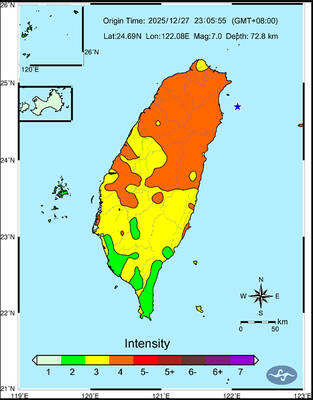A computer designed in Taiwan was sent to the International Space Station (ISS) for testing for a long-term contract, a Chungshan Institute of Science and Technology official has confirmed.
The SG100 Cloud Computer was designed by the institute after NASA opened the contract for the computer to worldwide bids, and it is capable of performing cloud-based computations and upgrading itself during space missions, the official said.
NASA selected the computer for its OA-7 mission after it passed the US space agency’s evaluations with a perfect score, the official added.

Photo courtesy of the Chungshan Institute of Science and Technology
NASA launched the OA-7 mission on April 18 to supply the space station with an Orbital ATK rocket, and the SG100’s components were included in the shipment for assembly at the station.
If the SG100 passes a six-month field trial, the institute will be contracted by NASA to design its next-generation space mission computers, the official said.
The SG100 Cloud Computer program was a joint effort by the institute, Academia Sinica and National Central University.
The Institute of Nuclear Energy Research and the Chang Gung Memorial Hospital’s Lin-kuo Branch allowed the design team to use their particle accelerator to test the computer’s performance in space-like conditions.
“Data generated by planning, design, analysis and simulation tasks involved in the process had all been evaluated by NASA experts... The final product was then subjected to NASA’s rigorous environmental testing, which the SG100 passed flawlessly,” the official said.
The design team worked with NASA on the computer used by the space station’s alpha magnetic spectrometer (AMS), a computer that has been in use at the station since 2001.
The AMS project was headed by Nobel laureate Samuel Ting, a Taiwanese-American physicist, who was also involved in the development of the SG100.
The OA-7 mission is to involve four key experiments, including testing of the SG100.
The institute last year announced that it was building a lunar lander for NASA’s Resource Prospector mission, which aims to be the first mining expedition on the moon in the early 2020s.
The lunar lander is expected to be completed by next year and the mission is expected to be launched in the early 2020s — if it is given the green light, institute officials said in July last year.

A magnitude 7.0 earthquake struck off Yilan at 11:05pm yesterday, the Central Weather Administration (CWA) said. The epicenter was located at sea, about 32.3km east of Yilan County Hall, at a depth of 72.8km, CWA data showed There were no immediate reports of damage. The intensity of the quake, which gauges the actual effect of a seismic event, measured 4 in Yilan County area on Taiwan’s seven-tier intensity scale, the data showed. It measured 4 in other parts of eastern, northern and central Taiwan as well as Tainan, and 3 in Kaohsiung and Pingtung County, and 2 in Lienchiang and Penghu counties and 1

FOREIGN INTERFERENCE: Beijing would likely intensify public opinion warfare in next year’s local elections to prevent Lai from getting re-elected, the ‘Yomiuri Shimbun’ said Internal documents from a Chinese artificial intelligence (AI) company indicated that China has been using the technology to intervene in foreign elections, including propaganda targeting Taiwan’s local elections next year and presidential elections in 2028, a Japanese newspaper reported yesterday. The Institute of National Security of Vanderbilt University obtained nearly 400 pages of documents from GoLaxy, a company with ties to the Chinese government, and found evidence that it had apparently deployed sophisticated, AI-driven propaganda campaigns in Hong Kong and Taiwan to shape public opinion, the Yomiuri Shimbun reported. GoLaxy provides insights, situation analysis and public opinion-shaping technology by conducting network surveillance

Taiwan is gearing up to celebrate the New Year at events across the country, headlined by the annual countdown and Taipei 101 fireworks display at midnight. Many of the events are to be livesteamed online. See below for lineups and links: Taipei Taipei’s New Year’s Party 2026 is to begin at 7pm and run until 1am, with the theme “Sailing to the Future.” South Korean girl group KARA is headlining the concert at Taipei City Hall Plaza, with additional performances by Amber An (安心亞), Nick Chou (周湯豪), hip-hop trio Nine One One (玖壹壹), Bii (畢書盡), girl group Genblue (幻藍小熊) and more. The festivities are to

AFTERMATH: The Taipei City Government said it received 39 minor incident reports including gas leaks, water leaks and outages, and a damaged traffic signal A magnitude 7.0 earthquake struck off Taiwan’s northeastern coast late on Saturday, producing only two major aftershocks as of yesterday noon, the Central Weather Administration (CWA) said. The limited aftershocks contrast with last year’s major earthquake in Hualien County, as Saturday’s earthquake occurred at a greater depth in a subduction zone. Saturday’s earthquake struck at 11:05pm, with its hypocenter about 32.3km east of Yilan County Hall, at a depth of 72.8km. Shaking was felt in 17 administrative regions north of Tainan and in eastern Taiwan, reaching intensity level 4 on Taiwan’s seven-tier seismic scale, the CWA said. In Hualien, the